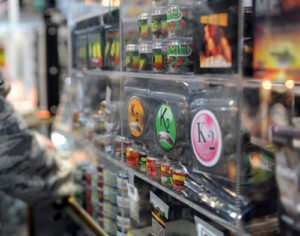Cheap, legal and readily available, K2, Spice and other synthetic drugs are in the news with stories of outlandish behavior and bizarre violence. But are they as dangerous as the media portrays them to be or is it all hype?

Synthetic drugs began appearing on the market in the 1980s and ‘90s, showing up in head shops and gas stations. Branded with bright colors, alleging to mimic the high of marijuana without any of the legal consequences. These chemical compounds act on the same receptors in the brain as THC (the active compound in marijuana) however at anywhere from 2 to 100 times the strength. And synthetics can kill. The high is characterized by a pronounced loss of muscle control and depersonalization. Violence and erratic behavior is not uncommon. The story of Richard Rojas, the man who killed 1 pedestrian and injured another 22 with his car in Times Square while high on K2 is just one of many recent violent incidents fueled by synthetic cannabinoids.
Why is Synthetic Marijuana Dangerous?
The Media and “Bath Salts”
Much has been made over the past few years about the abuse of cathinones or “bath salts”. A short-lived media panic drew scrutiny to the obscure drug. It’s possible that sensationalism surrounding the abuse of bath salts has obscured a very real problem by turning the discussion around synthetic drugs into a short-term media fad as opposed to addressing what, for many users, has become a chronic problem.
Synthetics & Addiction

Although research on these substances is still new, a growing body of anecdotal evidence indicates that synthetic cannabinoids are addictive. Users develop heightening tolerances the more they use, chasing the same high with more of the drug. Withdrawal symptoms can be severe. Users describe suicidal thoughts, vomiting, chills and fever. Much like heroin, addicts need doses just to “maintain” and keep from getting sick. The withdrawal is described as “worse than opiates”.
Legal or not, the physical toll- coupled with the irrational and violent behavior exhibited by users- makes the spread of these substances is something to be taken very seriously. Overdoses are becoming more common. Last year in Brooklyn a rash of overdoses were traced back to a particularly dangerous batch of K2. Vulnerable populations such as teens and the homeless are among those abusing synthetics, but it’s also attractive to people who have jobs that test for drugs.
Though they might be sold in stores, the consequences of synthetic drug use are dire and profound. The potential for addiction and abuse are high for these substances. The use and withdrawal symptoms are can result in medical emergencies. There is every reason to take synthetic drugs as seriously as any other that can threaten a life. If you or someone you know wants to break the chains of addiction, call us today.

